Branding is the cornerstone of small business success and has never been more important in marketing
If you are a small business owner, you probably hear the term branding thrown around more often than you can count. Company branding can be a tricky thing to nail down. The term itself is often used interchangeably with brand and brand identity. This adds to the confusion.
What is branding?
Branding is the action you take to shape your company’s everyday practices, values, and products and how you present them to your customers and audiences. Branding is a process that involves strategy, including deciding on your company name, deciding what your business offers, and the conversation you want to have with your customers.
Branding differs from brand and brand identity. A brand is a company itself, which is the result of your branding efforts. Your brand identity is everything visual about your company—from logos and color schemes to your business website, its products, and its packaging. Branding should be the effort you take to push your brand. Once your brand is established, you have completed your branding efforts. These three terms—brand, branding, and brand Identity—all comprise how you and your audience experience and see your company.

How do I define my business’s branding?
You have built your company up from the ground up, pouring months or years of work into making its products memorable to your customer. You might be wondering how your brand will come across to your customers, but before you overthink your company’s branding, you must remember that branding is the action you take to shape your company’s values and practices. The first step is to start with your product. What are you offering to your customers? What problems does it solve for them, and why does it matter? This is the most significant part of your brand.
The importance of branding your business
Branding is a complex task that begins with your product and ends with your customer’s affection for it. Branding helps people identify and recognize your products and organization. Branding allows you to build relationships with your customers, turning them into loyal customers. By creating a brand that people care about, you will put yourself ahead of businesses that aren’t using this to their advantage. There are three essential aspects of branding:
- Your brand represents you and the promise to your customers
- Your brand helps you connect with your customers emotionally
- Your brand helps you create clarity and stay focused
Long-term value and customer perception
Since a strong brand provides long-term business value, it is vital for small businesses. Branding in your marketing strategy cannot be overstated, even for small businesses. Your brand influences every aspect of your customer’s perceptions of your company, and branding builds trust, recognition, loyalty, and reputation. Branding is also an essential component of small business marketing, but it can sometimes be lost in all other priorities that come with staying afloat. Investing in branding for long-term success is crucial to small business survival. Branding is perceived through:
- Visual identity, including website, logo, and colors
- Advertising and communications
- Product and packaging design
- In-store experience, including pricing, sponsoring, and partnerships
These perceptions are based on many elements, including tangibles, such as brand promises, personality, reputation, and customer experiences and expectations.
The relationship between brand and marketing
Branding reaffirms who your company is, including its personality, purpose, and voice. While branding is the driving force behind customer retention, attraction, loyalty, and recognition in the long term, marketing is about achieving tactical goals through short-term marketing objectives, such as sales, revenue growth, customer acquisition, and expanded market dominance. Despite these differences, a successful brand marketing strategy understands the interplay between the concepts. Branding serves as a guide for your marketing plan, while marketing promotes your business, products, and services by building and leveraging the power of your brand. When these two forces combine, brand marketing increases company awareness. It establishes long-term affection through tactical objectives, including digital and social media marketing, to drive B2B lead generation, increase brand awareness, and enable growth. For this reason, investing in branding and marketing is crucial for long-term success.
Building your brand identity
Given the importance of branding in your marketing strategy and the long-term impacts of a strong brand identity, it is not surprising that developing a brand identity is a time-consuming and ongoing process that requires a lot of planning. Effective brand identity requires a superior design process and a lot of planning. Creating an attractive brand identity design process can be simplified by boiling the process down into the following steps:
- Decide on your target audience
- Outline your brand’s purpose
- Determine your brand’s personality
- Research competitor brands
- Develop your brand story and brand messaging
- Integrate your new visual identity into your brand
Integrating your visual branding
Creating a visual identity and integrating it into your brand requires you to think deeply about your business and consider what should be part of your messaging. The goal is to communicate your authenticity and core values to avoid falling into marketing traps, such as sending mixed messages about your brand that ultimately reach your customers and influence their decision to form a relationship with your product.
Establishing your brand’s purpose
As you set out to establish your brand’s purpose, it is essential to ask yourself the following questions:
- What problems do my products and services solve?
- What makes my brand unique?
- Why should customers care about my brand?
- What is my mission statement?
- Does my brand’s purpose support the specific brand promise I am making?
Spending the time and resources researching competitor brands is critical because your competition’s weakness can highlight your mission’s strength. The competition will show you how your competitors position their brands and the branding strategies they are deploying. Competitor research will reveal your competitor’s target audience, how your competitors are positioning their brands, how their target audience responds to that positioning, and how you can better differentiate your products and services. Conducting opposition research to establish your brand’s purpose further will significantly impact the development of your messaging strategies, helping you define who your target audience is.
Strong branding requires a complete understanding of how your brand voice wants to speak to your target audience. In fact, the more you narrow down your target audience, the more effective your branding strategies will be. Here are some elements that can help you be more specific in finding and developing your brand messaging:
- Demographics, such as age and gender
- Location of your target audience
- Location of similar competitors
- Sales and market statistics
Regular discussions about your services and how your existing customers respond will allow you to be more specific about your target audience. By analyzing your competitors, their customers, and your target audience, you will now be able to craft compelling messages that can speak directly to the customers who would benefit most from your product and services. This information will also help you to save valuable time and resources by deploying a Geofence initiative, whereby your company can set up a virtual perimeter and focus on customers within a specific radius around the primary location of your business. With the hard work behind you, the fun, creative part begins, and you can now focus on your brand story and messaging.
Brand story and messaging
It is true that behind every good brand, there is a great brand story told through consistent messaging. You can now connect emotionally with your target audience by telling the story of your brand’s journey, from concept to market. Knowing your brand messaging will allow you to develop consistency in your brand voice across all marketing and operational channels. Here are a few questions you should ask yourself along the way when developing your brand story:
- What motivated me to create this business in the first place?
- What are the highlights of the journey?
- What drove me to build this business?
- Which of my passions guided me in the direction of my business?
- In what ways are my products and services reflective of my core values?
Once your brand story is fully developed, it’s time to test its effectiveness on your target audience. This will help you identify where your story is failing to connect and how you can better reposition it in the future. As your brand story becomes more engaging, cohesive, and consistent, it is time to reiterate it to a broader audience via marketing.
Marketing your small business
Creating a marketing strategy is a great way to grow your small business. After you analyze your marketing budget, establish your target audience, and solidify your brand story, it is now time to launch marketing campaigns that will boost your brand’s awareness and attract more leads by focusing on:

- What is marketing, and why is it important?
- What are the different types of marketing?
- How do I develop a successful marketing strategy?
- What are my best marketing channels?
Marketing is the action of promoting your business and products to supply leads to your sales team. It involves creating campaigns that tell the story of your business to attract prospective customers to your brand. As previously discussed, conducting market research allows you to do this effectively by identifying your target audience and catering marketing campaigns toward those demographics that would most directly benefit from your product.
The power of marketing campaigns
Once a marketing campaign launches, you will review the analytics and campaign results to determine how many people it reached and attracted. This will help you better understand what marketing methods you’re doing right and which ones can be improved. Marketing campaigns are an effective way to tell others about your business, and some of the benefits of high-performing, targeted marketing campaigns include:
- An increased understanding of your product
- Content that informs and engages your audience so they can better understand your product, brand, and industry
- Valuable educational content to establish your business as an industry leader
- Increased retention rates
In addition to establishing your business as an industry leader, marketing campaigns build customer loyalty, leading to customers staying with your business for the long haul. Marketing campaigns sometimes cost less than traditional print media and digital advertising, which is an added benefit. Here are a few long-term benefits of high-performing, targeted Marketing Campaigns:
- Improved lead generation—Targeted marketing campaigns help direct your campaigns toward people who benefit the most from your product and increase the likelihood of them making a purchase, telling their circle, and supplying you with more leads.
- Increased awareness of your product—Much like targeted marketing campaigns, the content you create regularly can now be catered to audiences and delivered in immediately shareable ways. You actively reach a wider audience when people share your content with their network.
Types of marketing
Marketing comes in many forms, and you will decide on the methods that uniquely fit your customer and business needs. Building effective strategies attract more leads and provide impressive results. A few types of marketing that can be used to launch campaigns include:
- Content marketing—The writing and distribution of consistent copy that attracts and retains your target audience. Content marketing is available in various forms, such as blog posts, articles, and emails. Your goal is to create consistent content that educates, informs, and directly relates to your audience while offering valuable information that benefits prospects and customers. This builds a strong relationship with your audience by highlighting the unique solutions your products and services have to offer.
- SEO —Search Engine Optimization (SEO) improves the ranking of your website on search engines by properly optimizing your content to reach specific SEO standards. Your website will now appear on the first page of search engine results. Once your target audience is identified, and your marketing mix has been specifically catered to connecting with those potential customers, a Geofence is established, giving you the top spot in search results. For example, if your small business is a bakery, it will be the first bakery that pops up when someone turns to Google to find out who the top bakers are in their area. SEO-optimized content helps you show up organically on search results, meaning your website appears for free rather than through paid advertising. Optimizing your content for search engines entails creating valuable content that is easy to read and layered with keywords and relevant information your target audience seeks.
- Analytical marketing—By studying your website analytics, you will better understand how well your website and content perform. Different analytics tools provide a range of information regarding how users navigate your website, what pages your customers are visiting, the links they’re clicking, and the demographic and geographical information that will help you better target them the next time.
- Social media marketing—Building a social media profile and adding regular updates will help you engage with your audience on a rolling basis. Think of these updates as an invitation for customers to engage with your business in a continuous and hopefully lifelong conversation that can be passed down to the next generation. Think of a time when you were loyal to a small business because your parents were loyal to them when you were a kid. Longevity can only be achieved when you create a meaningful, emotional connection with your customers of today—customers that will eventually pave the way for your customers of tomorrow. Many social media platforms have analytical tracking tools that list who are engaging with your posts, which will help you to cater content further toward your target audience. Social media also allows you to interact with your customers directly on various platforms, where you can instantly reply to them in comment sections or direct messages. Not only will this help you identify what aspects of your business they love, but it will inform you on areas in which it can be approved. When the interaction grows in a specific area of your marketing, branding, product, or services, it might be time to pivot to another strategy when things are not working or reinforce the aspects. Social media also allows you to regularly publish posts that provide relevant information to your followers or create engaging posts to express your brand’s voice and continue telling its story.
You can then:
- Share posts with links to your recently published blogs
- Share pictures of your staff at events
- Highlight the partnerships and projects you are collaborating on
Whether these projects are local volunteer efforts or entrepreneurial initiatives within your community, you will now bring other businesses into your orbit, allowing your network to grow.
- Interactive marketing—Live video Q&As and product demonstrations are the new cutting-edge digital and media initiatives that allow your audience to interact with your business in a more contemporary and engaging way. Not only that, but the content can be archived, so when new, potential, curious customers come along, they can instantly access your company’s history and story. Additionally, interactive marketing is more effective when launching promotions and discounts on your products and connecting with the younger generations.
- Email marketing—This effective marketing technique allows you to customize messaging to prospective customers and leads, depending on their stage in the buyer’s journey. The buyer’s journey encompasses the progressive stages of the purchasing process, including awareness, consideration, and decision. For example, creating emails for customers who are still researching your product might nudge them into a purchasing decision. Email marketing to share educational resources and industry-specific content will also help potential and existing customers learn more about your brand and product while simultaneously building a lasting relationship with you and your company. You might also consider creating a digital newsletter to keep your fans up-to-date on new product features or industry-related information.
- Paid advertising—This form of marketing involves using your budget to publish targeted campaigns, which is crucial in the early stages of your initial business launch when money is tight, and profits have yet to be locked in. Narrowing in on your target audience and refining your message is key to unlocking the value of paid advertising, which can help promote your business and increase its appearance on social media, search engines, and elsewhere on the internet. Paid advertising allows you to build brand awareness by reaching larger audiences as you appear on more people’s social media feed and in search engine results. Still, the money will be wasted if you haven’t done the leg work required to make an impact.
- Print marketing—This type of marketing appears in printed media, such as magazines, newspapers, or billboards. By researching your target audience, you will understand which kind of print media your customers use and when and where to place your advertisement to generate as significant an impact as possible.
Developing your marketing strategy
Now that you have identified your target audience, refined your brand’s value, mission, purpose, voice, and story, and selected the type of marketing that works best for your business needs, it is not time to develop your marketing strategy.
Like a marketing campaign, developing your marketing strategy involves careful market research and established branding. Follow these steps to build an effective marketing strategy that will have longevity and make a lasting impact:
Set goals—Marketing goals are geared toward the revenue you’d like to generate, how much traffic you hope will reach your site, the customer retention rate you’d like to increase, and conversion rates you’d like to boost.
Market research—Once again, the success of your business depends on how well your message lands, and the engagement of your message depends on the market research you’ve conducted to cater content to your unique audience. I cannot overemphasize the importance of research. The research will help you better understand your customer’s needs and buying habits and provide the tools necessary to make this assessment as accurate as possible. Surveying via email or calling customers directly will help educate you on why existing customers like your product or brand. This will allow you to effectively build and develop a customer prototype or buyer personas. Once an overall customer persona is established, you can now set out to target your prototypes, i.e., potential customers that are most like your loyal customers. You can directly communicate in ways they will positively respond to, optimizing your outreach.
Here are some questions you might want to consider asking your existing loyal customers:
- What do they like most about your product?
- How does your product benefit them?
- Where can your company improve?
- How would they describe your brand?
- What are their spending habits?
- What is their demographic, i.e., age, gender, occupation, location?
Remember, when branding and marketing your small business, the goal is to retain and nurture your most valued customers. Without them, your business will not be able to survive.

Barbara Talabisco
President and CEO
Wakefield Talabisco International
Since founding Wakefield Talabisco International in 1992, Barbara has brought her vast network of personal contacts and in-depth industry understanding to the firm. Her dynamic, results-driven personality, ingenuity, and combination of creative candidate-development skills consistently generate successful placements. Barbara leads searches for corporate clients ranging from innovative start-ups to billion-dollar multinationals.
Barbara’s experience in the executive-search industry spans more than 30 years. With a background in research, she moved rapidly to the level of partner and has contributed to the success of the well-known firms Judd Falk, Rene Plessner, Kurt Einstein Associates, and Gilbert Tweed Associates. Barbara’s industry specialization encompasses consumer products, financial services, direct selling/direct marketing, fashion, cosmetics, technology, and retail. Her clients include some of America’s fastest-growing companies.
Read Barbara’s previous blog on small business mistakes here.
Join the Markaaz Dashboard to get the small business resources and monitoring you need all in one spot.





